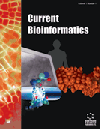- Home
- A-Z Publications
- Current Bioinformatics
- Previous Issues
- Volume 4, Issue 1, 2009
Current Bioinformatics - Volume 4, Issue 1, 2009
Volume 4, Issue 1, 2009
-
-
A Review of the Primer Approximation Multiplex PCR (PAMP) Technique for Detecting Large Scale Cancer Genomic Lesions
More LessAuthors: Kedsuda Apichonbancha, Bhaskar Dasgupta, Jin Jun, Ion Mandoiu and Emma MendoncaPrimer Approximation Multiplex PCR (PAMP) is a recently introduced experimental technique for detecting large-scale cancer genome lesions such as inversions and deletions from heterogeneous samples containing a mixture of cancer and normal cells. In this chapter we will first review previous solutions for the problem of selecting sets of PAMP primers that minimize detection failure probability and subsequently review Read More
-
-
-
Computational Biology of Olfactory Receptors
More LessOlfactory receptors, in addition to being involved in first step of the physiological processes that leads to olfaction, occupy an important place in mammalian genomes. ORs constitute super families in these genomes. Elucidating olfactory receptor function at a molecular level can be aided by a computationally derived structure and an understanding of its interactions with odor molecules. Experimental functional analyses of ol Read More
-
-
-
Molecular Genetic Markers: Discovery, Applications, Data Storage and Visualisation
More LessAuthors: Chris Duran, Nikki Appleby, David Edwards and Jacqueline BatleyMolecular genetic markers represent one of the most powerful tools for the analysis of genomes and enable the association of heritable traits with underlying genomic variation. Molecular marker technology has developed rapidly over the last decade and two forms of sequence based marker, Simple Sequence Repeats (SSRs), also known as microsatellites, and Single Nucleotide Polymorphisms (SNPs) now predominate applicati Read More
-
-
-
Digital Signal Processing in the Analysis of Genomic Sequences
More LessDigital Signal Processing (DSP) applications in Bioinformatics have received great attention in recent years, where new effective methods for genomic sequence analysis, such as the detection of coding regions, have been developed. The use of DSP principles to analyze genomic sequences requires defining an adequate representation of the nucleotide bases by numerical values, converting the nucleotide sequen Read More
-
-
-
Software for Determination of Biological Age
More LessAuthors: Kartlos J. Kachiashvili and David Yu. MelikdzhanianAn original software package for determination of biological age has been offered. The package is simple for understanding and convenient in application. It is designed for the users who are not professionals in the fields of applied statistics or computer science. The problems and the algorithms realized in the package, the features and the possibilities of their application are described in brief. The package can be used Read More
-
-
-
‘Load Points’ and ‘Choke Points’ as Nodes for Prioritizing Drug Targets in Pseudomonas aeruginosa (Supplementary)
More LessAuthors: Deepak Perumal, Chu S. Lim, Kishore R. Sakharkar and Meena K. SakharkarBiological pathways information has accumulated along with Genomic sequence data. These metabolic pathways help us in understanding network robustness and complex reaction networks. They also provide a framework for improved understanding of microbial physiology and for antimicrobial drug discovery. This article is an attempt to understand the local and global properties of metabolic networks in P. aerugin Read More
-
-
-
Structural Bioinformatics: From the Sequence to Structure and Function
More LessProteins are the molecules of life which are involved in cellular processes. The functional specificity of a protein is linked to its structure. A great section of bioinformatics deals with the prediction, analysis and visualization of protein 3D structures. High-throughput methods for the determination of protein structures provide the information needed to build structure-activity relationships. The accessibility of these str Read More
-
Volumes & issues
-
Volume 20 (2025)
-
Volume 19 (2024)
-
Volume 18 (2023)
-
Volume 17 (2022)
-
Volume 16 (2021)
-
Volume 15 (2020)
-
Volume 14 (2019)
-
Volume 13 (2018)
-
Volume 12 (2017)
-
Volume 11 (2016)
-
Volume 10 (2015)
-
Volume 9 (2014)
-
Volume 8 (2013)
-
Volume 7 (2012)
-
Volume 6 (2011)
-
Volume 5 (2010)
-
Volume 4 (2009)
-
Volume 3 (2008)
-
Volume 2 (2007)
-
Volume 1 (2006)
Most Read This Month
Article
content/journals/cbio
Journal
10
5
false
en


